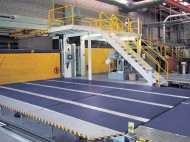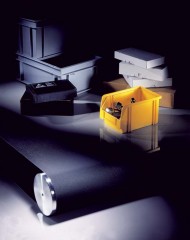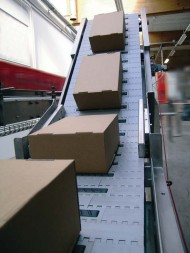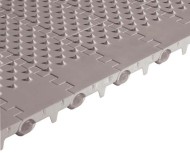 The current economic climate is putting the industry under increasing pressure to not only control costs, but also improve efficiency. Jim Dowell, Strategic Industry Manager at Habasit Rossi, explains why accurate consultation to match the right conveyor belt solution to the right application is essential for maximising plant output.
The current economic climate is putting the industry under increasing pressure to not only control costs, but also improve efficiency. Jim Dowell, Strategic Industry Manager at Habasit Rossi, explains why accurate consultation to match the right conveyor belt solution to the right application is essential for maximising plant output.
The rising cost of raw materials is a key issue for the materials handling industry, which, together with weak currencies, rising interest rates, and high energy costs, is proving to be a real challenge when it comes to staying cost efficient.
The performance of conveying systems can make a real difference to the overall efficiency of a plant. As such, the sector as a whole stands to benefit from some measureable improvements by re-assessing its conveying systems, in particular looking at whether they perform well enough when it comes to energy use, safeguarding product quality and minimising maintenance and downtime.
 However, to fully maximise the potential output of a plant, engineers must ensure that they select the right conveyor belt for the right application. They must look at whole life costs, energy efficiency and maintenance, as well as whether a belt is really suited to the application that it is intended for.
However, to fully maximise the potential output of a plant, engineers must ensure that they select the right conveyor belt for the right application. They must look at whole life costs, energy efficiency and maintenance, as well as whether a belt is really suited to the application that it is intended for.
Superior Solutions
Actual belt cost is always going to be an issue for the industry – now more so than ever. However, increasingly the value of reducing whole life costs through reduced maintenance and energy consumption is being recognised. High performance, well specified belts will result in far more efficient production lines and reduce the amount of unplanned production stoppages, minimising losses in productivity and processing wastage.
Using their expert industry specific know-how, application engineers, technicians and joining specialists are now at customer’s disposal to supply professional consultation and excellent support when it comes to providing outstanding belting solutions of the highest quality, tailored to their specific needs.
Innovative Technology
Choosing the right technology can ensure that a plant is working at its maximum capabilities.
Whether fabric, plastic modular or power transmission, belts must be able to offer reliability, an increase in system speed, low noise operation, a short turn around time and system flexibility.
 As the preferred solution for the materials handling industry, coated fabric belts offer excellent cost-value ratio for general conveying purposes and are suitable for rough and rugged conditions.
As the preferred solution for the materials handling industry, coated fabric belts offer excellent cost-value ratio for general conveying purposes and are suitable for rough and rugged conditions.
Fabric belts feature a wide range of surface types, structures and belt lengths and offer long belt life due to longitudinal flexibility. They are also excellent for ascending, descending and horizontal conveying and merging applications.
PVC coated belts have a simple and fast joining method to deliver an adhesive free joint and short machine downtimes. They are also flame retardant and available with an impregnated fabric surface for constant low coefficient of friction over the belt life.
TPU coated belts are ideal for demanding applications such as narrow transfer points or oily environments. They feature a light weight belt construction, specifically designed for heavy duty applications. They have low energy consumption and are suitable for high speeds and rapid acceleration.
Advanced Products
Plastic modular belts, which can be used in a wide range of belting applications, are made from injection moulded thermoplastic modules, which are connected with solid plastic rods.
The all plastic design promotes long life and superior performance in many applications. Multiple widths are achieved by using a ‘bricklayed’ pattern, which also promotes high lateral and diagonal belt strength and stiffness.
These belts are durable, reliable and built to withstand the demands of modern materials handling environments, where belts are often required to run for 24 hours a day, 365 days per year.
 Maximum incline or decline angles can vary, depending on conditions and materials being transported and technical sales and customer care teams can easily calculate and advise customers of best possible solutions.
Maximum incline or decline angles can vary, depending on conditions and materials being transported and technical sales and customer care teams can easily calculate and advise customers of best possible solutions.
A range of friction plastic modular belts, which can be used in distribution centres, airports, general conveyor systems, packaging end-lines and checkouts, have also been developed with a variety of surface profiles to grip products such as boxes travelling up steep inclines and maintain product orientation.
In trials, these belts reduced product damage, downtime and overall maintenance, while increasing belt life and throughput.
Customer Satisfaction
Year on year, manufacturers are looking for continuous improvement, which is particularly important in the current economic climate. The leading conveyor belt innovator puts a strong focus on R&D and is constantly striving to develop new solutions to help manufacturers improve efficiency and keep costs low.
Specialist conveyor belts can be retrofitted, as well as installed into new facilities and the leading supplier offers belts that are backed by localised repairs, which means that downtime is reduced in the event of a breakage.
Training programmes are available that cover fabrication, installation, assembly, maintenance and belt repair, ensuring optimal use of products on-site to prolong a belts life cycle.
Like virtually all sectors, the UK materials handling industry is facing a real challenge in this economic climate. However, the leading belt manufacturer has developed the products, technical support and training to ensure production facilities continue to run at optimum efficiency to control costs, minimise downtime and maximise productivity during the difficult times ahead.
Habasit Rossi Limited
Ian Thornham,
Sales & Marketing Director
Tel: 0844 835 9555
www.habasitrossi.co.uk




1 Comment
Dear Sirs,
We have a Tissue converting company, where the already packed single rolls going out from 2 packing machines (200 rolls/min each) should be manually packed by he workers inside Nylon Bags.
My idea is to use a conveyor similar somehow to the Airport ones.
I appreciate if I can get assistance in this subject.
BR
JACK Monhem
+234 803 3012274